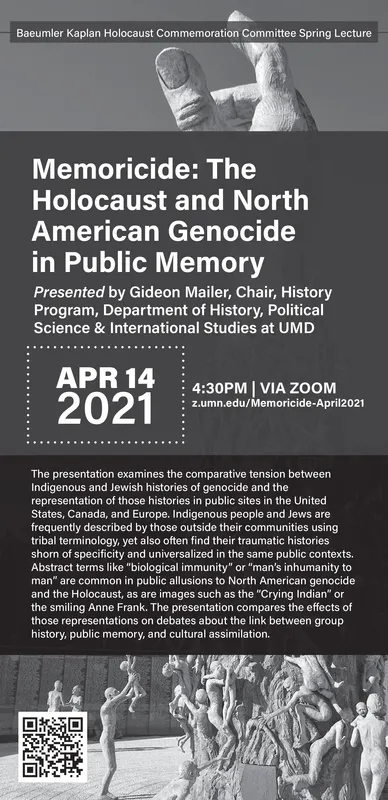Advertisement

-
Published Date
April 9, 2021This ad was originally published on this date and may contain an offer that is no longer valid. To learn more about this business and its most recent offers, click here.
Ad Text
Baeumler Kaplan Holocaust Commemoration Committee Spring Lecture Memoricide: The Holocaust and North American Genocide in Public Memory Presented by Gideon Mailer, Chair, History Program, Department of History, Political Science & International Studies at UMD APR 14 2021 4:30PM | VIA ZOOM z.umn.edu/Memoricide-April2021 The presentation examines the comparative tension between Indigenous and Jewish histories of genocide and the representation of those histories in public sites in the United States, Canada, and Europe. Indigenous people and Jews are frequently described by those outside their communities using tribal terminology, yet also often find their traumatic histories shorn of specificity and universalized in the same public contexts. Abstract terms like "biological immunity" or "man's inhumanity to man" are common in public allusions to North American genocide and the Holocaust, as are images such as the "Crying Indian" or the smiling Anne Frank. The presentation compares the effects of those representations on debates about the link between group history, public memory, and cultural assimilation. Baeumler Kaplan Holocaust Commemoration Committee Spring Lecture Memoricide: The Holocaust and North American Genocide in Public Memory Presented by Gideon Mailer, Chair, History Program, Department of History, Political Science & International Studies at UMD APR 14 2021 4:30PM | VIA ZOOM z.umn.edu/Memoricide-April2021 The presentation examines the comparative tension between Indigenous and Jewish histories of genocide and the representation of those histories in public sites in the United States, Canada, and Europe. Indigenous people and Jews are frequently described by those outside their communities using tribal terminology, yet also often find their traumatic histories shorn of specificity and universalized in the same public contexts. Abstract terms like "biological immunity" or "man's inhumanity to man" are common in public allusions to North American genocide and the Holocaust, as are images such as the "Crying Indian" or the smiling Anne Frank. The presentation compares the effects of those representations on debates about the link between group history, public memory, and cultural assimilation.
